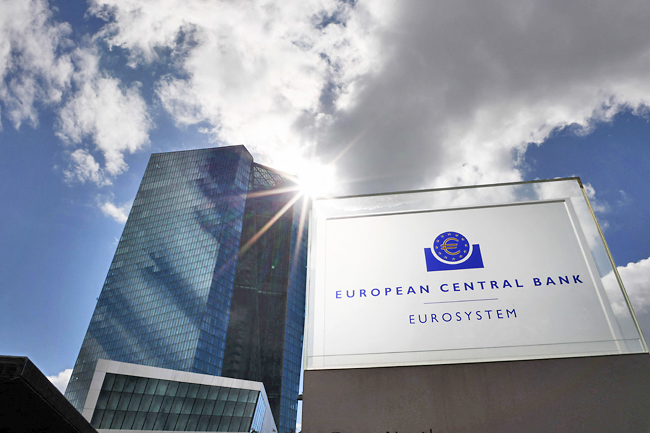FRANKFURT (XINHUA) – The European Central Bank (ECB) reduced its key interest rate (deposit rate) by 25 basis points to 3.5 per cent on Thursday due to weak consumer demand and stagnating growth in key economies like Germany.
It was the same size as its previous cut in June, which marked the end of a record-breaking hiking cycle that had commenced in mid-2022 to tame surging consumer prices.
The interest rate cuts underscore the persistent challenges facing the eurozone economy, and reflect a broader shift in international markets, which are increasingly prioritising economic growth amid lingering global uncertainties.
CUTTING, WATCHING AND REPEATING
Although ECB President Christine Lagarde emphasised that future rate decisions will be data-driven, with no predetermined paths for cuts, analysts generally believe that interest rate cuts will continue.
“All eyes will be on… the likelihood of another 25 basis point cut being announced as early as October,” said economist Antonio Villarroya at Banco Santander, Spain’s largest lender.
The risk of the economy overheating due to further rate cuts appears low, suggesting that another rate cut before the end of the year is very likely, said European market strategist Michael Field at the investment research firm Morningstar.
The ECB’s pattern of cutting, watching and repeating is likely to continue, he added.
Germany’s Chamber of Commerce and Industry (DIHK) said that the interest rate cut makes sense above all because the German economy remains in a state of stagnation.

At the beginning of the year, there had already been urgent warnings that another difficult year was looming without far-reaching measures to improve the general conditions for local companies, noted DIHK, adding that it now looks like 2024 will also be a year without growth, perhaps even a year with falling gross domestic product like 2023.
Growth in Europe has been sluggish, at 0.3 per cent in the second quarter of this year and about one per cent for the year based on first-half performance.
According to Nikkei Asia, in the medium term, the eurozone is entering a difficult situation where there is a need to prevent inflation from reigniting while simultaneously considering economic stability through phased rate cuts.
A GLOBAL SHIFT
The United States (US) Federal Reserve (Fed) likely won’t be far behind in joining the rate-cutting process, AP news agency reported.
Major central banks including the Fed are shifting their focus from fighting inflation to supporting growth as inflation falls steadily toward two percent and economic momentum falters, reported The Wall Street Journal.
After the ECB lowered its deposit rate, investors are now wagering on the size and extent of the rate cut by the Fed next week, with money markets seeing a 43-per-cent chance for a 50 basis points reduction on September 18, said a news report.
“I think there’s a strong case for 50,” the report cited former chief of the New York Fed Bill Dudley, as saying.
In developed economies, Britain announced its first interest rate cut in four years and five months this August, while Canada lowered its benchmark rate three times in a row earlier this month.
Switzerland and Sweden are also very likely to implement further rate cuts.
According to a Nikkei Asia report, the global shift toward rate cuts by central banks is driven by the stabilisation of price surges caused by the situation in Ukraine and other factors.
If economic weakness continues into 2025 and pushes inflation below target, more drastic monetary policy measures may be necessary, said chief European economist Simon Wells at HSBC.
CHALLENGES REMAIN
While rate cuts are aimed at stimulating borrowing and investment, it is hard to ignore the structural problems within the eurozone.
Chief investment strategist Jan Viebig at the private bank Oddo BHF, an independent Franco-German financial group, warned that inflation in the eurozone, especially in the service sector, has not yet been defeated.
Monetary policy is not designed to solve structural problems in European economic policy and cutting interest rates too quickly carries risks, said Viebig.
Consumer confidence in the eurozone has been shaken and consumption has fallen sharply, particularly in Germany, the eurozone’s largest economy, and layoffs and corporate bankruptcies are adding to the uncertainty, said Wells.
For instance, Volkswagen Group announced September 2 that it is considering closing an automotive manufacturing plant and a components factory in Germany, further exacerbating the situation.
According to the DIHK, the main cause for concern is that the manufacturing and construction industries are shrinking.
The reduction in interest rates is now helping because the financing conditions for investments are becoming somewhat more favourable, however, the German government is still required to finally gear its policy towards a clear, noticeable growth path, said the DIHK.
While gradual declines in borrowing costs should support economic recovery in Europe, the region is contending with greater challenges than high interest rates, reported the WSJ, quoting a report on the competitiveness of the European Union economy by former ECB President Mario Draghi published earlier this week.
“If Europe cannot become more productive, we will be forced to choose… We will not be able to finance our social model. We will have to scale back some, if not all, of our ambitions,” Draghi wrote.





